– Barley Li, Applications Engineering Manager – Technical Content, APAC.
Low-power wide-area network (LPWAN) cellular wireless technologies for the Internet of Things (IoT), such as Long-Term Evolution Machine Type Communication (LTE-M) and NarrowBand-IoT (NB-IoT), offer over a kilometer (km) wireless connectivity range for battery-powered devices using existing and proven cellular infrastructure.
New Radio+ (DECT NR+) is a license-free LPWAN alternative for applications requiring a cellular-like approach for massive IoT deployments. All three approaches can be complex to implement for developers, even for those with short-range wireless experience.
Working with a solution provider that offers pre-certified products with integrated LTE-M, NB-IoT, or DECT NR+ protocol software stacks and automated modems can offset the LPWAN design complexity. Such solutions allow the developer to focus more on application differentiation and achieve time-to-market targets.
This article summarizes the benefits of LTE-M, NB-IoT, and DECT NR+ for long-range IoT connectivity and discusses implementation challenges. It then introduces a combination cellular IoT and DECT NR+ device and associated development kit from Nordic Semiconductor and shows how they can be used to overcome these challenges.
Why use LTE-M, NB-IoT, or DECT NR+ wireless?
To be a fundamental part of the global network forming the Internet, IoT devices must be able to communicate with the cloud using Internet Protocol (IP) without the use of costly gateways. In some applications, such as agriculture, smart cities, and environmental monitoring, communication must be carried out over long distances and require minimal maintenance. The latter translates to low power consumption to maximize battery life.
LTE-M and NB-IoT offer a cellular solution to these challenges. They are based on specifications set by 3GPP, so they are IP interoperable and provide km-plus range. LTE-M and NB-IoT operate in frequency bands from 698 megahertz (MHz) to 960 MHz, and 1710 MHz to 2200 MHz, respectively. The technical details of LTE-M and NB-IoT are summarized in Table 1.
|
Table 1: Shown is a comparison between LTE-M and NB-IoT.
DECT NR+ provides an alternative for applications that require long-range connectivity without a license fee. It is based on 5G specifications, operates in the 1900 MHz band, can support high-density LPWANs, and is suited to machine-to-machine (M2M) communications and city-wide air quality monitoring.
Simplifying RF design
Implementing RF designs is challenging for many developers and can frequently compromise time-to-market schedules. However, some hardware challenges can be overcome by selecting an integrated solution that hides much of the complexity. One example is Nordic Semiconductor’s nRF9161 system-in-package (SiP) (Figure 1).
The SiP incorporates an Arm® Cortex®-M33 processor dedicated to application software and a modem supporting LTE-M, NB-IoT, and DECT NR+ RF interfaces. It also includes an RF front-end (RFFE) and a power management system, all in a 16.0 x 10.5 x 1.04 millimeter (mm) land grid array (LGA) package. The modem supports IPv4/IPv6 and encrypted firmware-over-the-air (FOTA) updates. The application processor is supported by 1 megabyte (Mbyte) of flash memory and 256 kilobytes (Kbytes) of RAM.
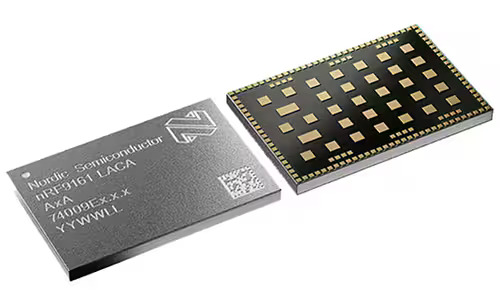
The SiP also features a GNSS receiver for applications such as location tracking. Interfaces and peripherals include a 12-bit analog-to-digital converter (ADC), real-time clock (RTC), Serial Peripheral Interface (SPI), Inter-Integrated Circuit (I²C), Inter-IC Sound (I²S), Universal Asynchronous Receiver/Transmitter (UART), pulse density modulation (PDM), and pulse width modulation (PWM). The SiP allows the development of a cellular or DECT NR+ IoT solution using a single device, an antenna, battery, SIM or eSIM, and a sensor (Figure 2).
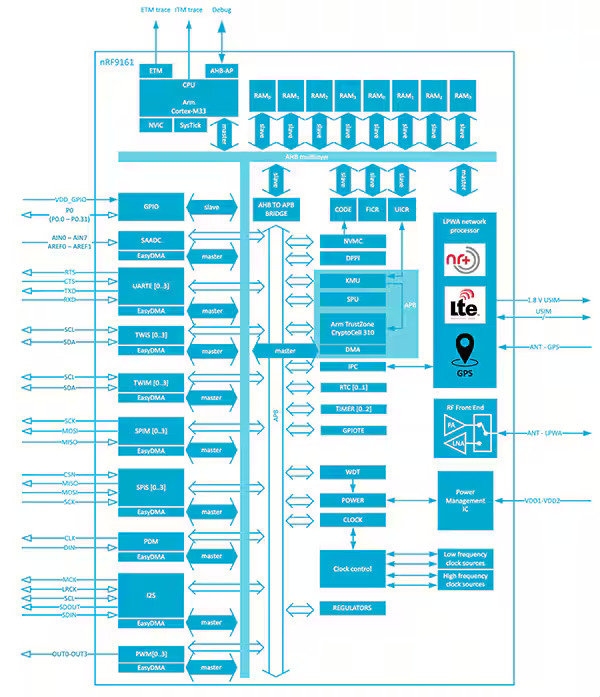
Software design challenges
The challenges of RF IoT design extend to the software. The cellular and DECT NR+ stacks are large and highly complex; building either from scratch requires protocol specialists. In the case of LTE-M and NB-IoT, the developer must implement cellular-specific attention (AT) commands once the stack is built and tested. These are the basis of communication between any cellular modem and its host controller. They are mainly used to configure and debug the modem, and enable network connection via mobile network operators (MNOs).
Nordic eases software coding problems by supplying a proven and stable LTE-M stack pre-programmed into the SiP’s modem. In addition, Nordic’s Serial LTE Modem application handles AT commands instructing the modem to transmit and receive data.
Beyond the engineering challenges, cellular modems must also meet strict region-specific certification and regulation requirements. These include global certifications to ensure compatibility with the LTE specifications, enabling the end device to communicate across LTE-M or NB-IoT networks. Additionally, some MNOs have their own certification requirements.
Again, Nordic has eased the developer’s burden by pre-certifying the nRF9161 SiP to operate in the most critical regions, key networks, and main LTE bands on those networks.
Using the nRF9161 development kit
While the nRF9161 SiP eases some critical hardware and software challenges associated with cellular IoT and DECT NR+ development, creating a working prototype still requires effort. To expedite the design process, Nordic offers the nRF9161 DK development kit (Figure 3) and a suite of software tools. The tools are spearheaded by the company’s nRF Connect SDK, a unified development environment for Nordic’s wireless solutions.
The dev kit incorporates the SiP and includes the necessary circuitry to enable a fully functional prototype. The kit features a dedicated LTE-M/NB-IoT and DECT NR+ antenna and an integrated patch antenna for GNSS. Programming and debugging are enabled through the onboard SEGGER J-Link, and the kit comes bundled with a SIM card preloaded with data. It also supports the use of a Software SIM, further reducing power consumption.
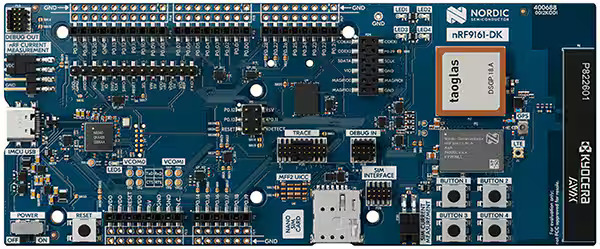
To get started developing with the nRF9161 kit, the SIM card must be plugged in (or the eSIM activated), the PROG/DEBUG SW10 switch set to “nRF91”, and the kit must be connected to a desktop computer using a micro-USB 2.0 cable. The dev kit requires a Windows, macOS, or Ubuntu Linux operating system (OS).
The next step is to install Nordic’s nRF Connect for Desktop and activate the software. From there, it is possible to install the Quick Start application, a tool for guided setup and installation procedures. The software simplifies updating the dev kit firmware and activating the SIM card. To transmit data from the kit to the cloud, the developer can set up a Nordic nRF Cloud account or connect to other cloud services.
The Quick Start application will then direct the developer to Nordic’s nRF Connect SDK. The SDK operates with Visual Studio Code, a popular integrated development environment (IDE), using Nordic’s nRF Connect for VS Code extension. The SDK is used to develop applications and includes useful samples such as retrieving a device’s location using GNSS, cellular, or Wi-Fi positioning, and transmitting sensor data from the nRF9161 kit to the cloud.
Once the application is built, programming the onboard nRF9161 SiP’s Arm application processor is simple. The first step is to connect the kit to a PC using a USB cable and power it up. From the nRF Connect for VS Code extension, the developer must click the “Flash” option in the “Actions View.” A notification appears, displaying programming progress and confirming completion.
The dev kit also allows the developer to check the LTE-M, NB-IoT, or DECT NR+ RF signal. Good RF performance is essential for maximizing the communication range between the IoT device and the base station. To make the measurement, a cable is fitted between the small coaxial connector (J1) on the kit and a spectrum analyzer (Figure 4).
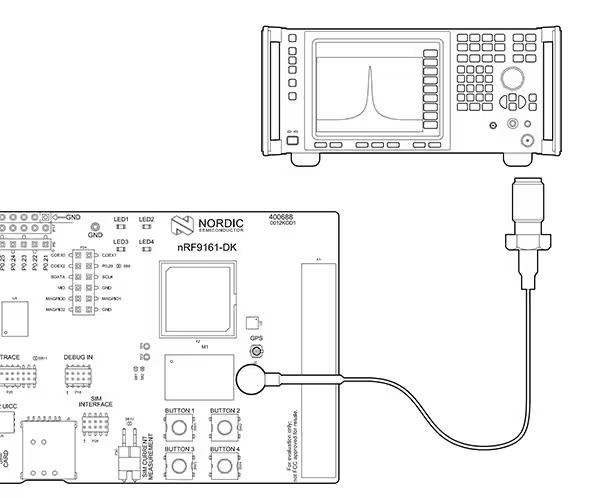
Advanced development tools for the nRF9161 DK
Once an application is programmed, Nordic offers two tools that allow the developer to observe its performance. The first is the Power Profiler Kit II (PPK2) (Figure 5). This standalone unit can measure the dev kit’s current draw across a range of 200 nanoamperes (nA) to 1 ampere (A) with a resolution that varies between 100 nA and 1 milliampere (mA). The PPK2 can also supply up to 5 volts at 1 A to the dev kit.
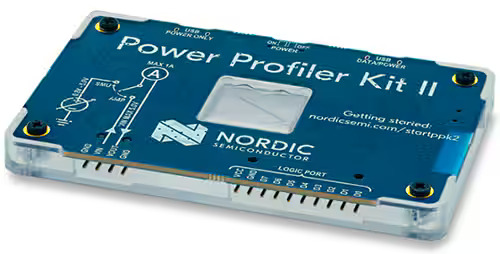
The PPK2 is used with a Power Profiler app, part of the nRF Connect for Desktop software. The developer can use the app to analyze the average and instantaneous current consumption of the nRF9161 kit when running an application. Readings can be taken over an extended duration while simultaneously zooming in on a millisecond interval if required. The measured data can be exported for further processing.
The power consumption analysis allows the developer to see where the application code can be modified to save power to extend the design’s battery life (Figure 6).
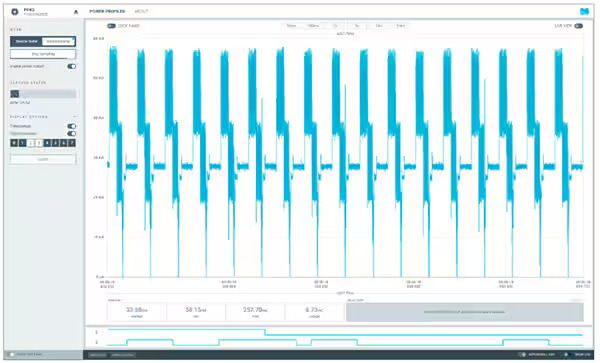
Nordic’s Cellular Monitor tool aids application development and is supported by the nRF Connect for Desktop software. The monitor shows what the nRF9161 SiP’s modem is doing as the dev kit runs the application. This includes network performance, device status, and data transmission. These details allow the developer to analyze modem traffic and optimize application performance. The information is displayed on a serial terminal.
Conclusion
LTE-M, NB-IoT, and DECT NR+ LPWAN technologies support reliable, secure, and scalable long-range connectivity for IoT devices, but developing wireless hardware and software devices can be challenging. Nordic’s nRF9161 SiP, embedded protocol software and supporting nRF9161 DK dev kit and apps reduce much of the design complexity.
The article has been sourced from: DigiKey India




